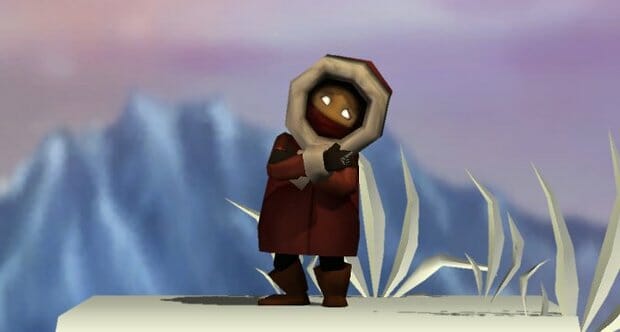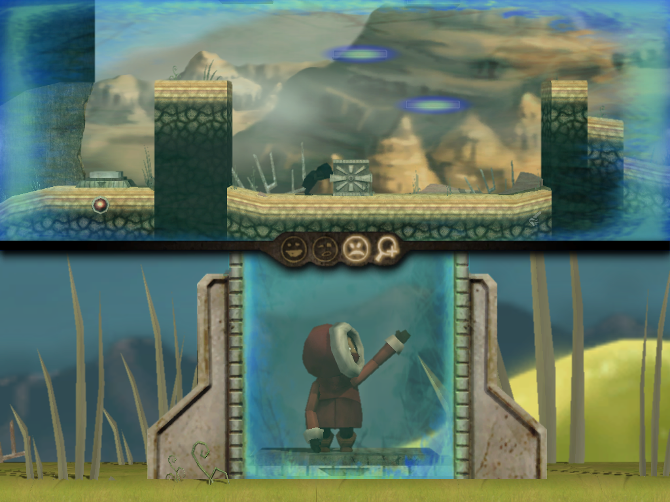
Way is a game about people. It’s about friends and strangers, about family members, about anyone willing to take twenty minutes to explore the surprising results of a 12-week student project. A brief yet haunting experience, Way is a co-operative side-scrolling platformer that hinges on a simple conceit: you can see things that your partner cannot. In order to “win” the game, you will have to help one another.
There’s a catch.
Words do not exist in Way. You will not be able to communicate via spoken or written language. Instead, you will have to rely on your aptitude for puppetry, on your knack for conveying a message with the angle of an arm or a tilt of your avatar’s head.
Interestingly enough, non-verbal communication, especially here, is both easier and harder than you might think it is. What you may perceive as a clear-cut message, others might misinterpret as an act of wanton silliness and vice versa. However, that’s the pivotal reason Way works. It isn’t the graphics, the platforming, or the puzzles – it’s how Way orchestrates an intense rapport between two people.
![]()
I start up Way. Within seconds, my partner connects to the game. The screen darkens for a moment. When it brightens again, I find myself staring into the white, pupil-less gaze of my blue-clad nomad. He’s extremely friendly-looking for someone with such vacant eyes.
I set off towards the left. Along the Way, I pass cave paintings that explain the game’s controls; the directional keys are used for movement, the left mouse button operates one arm, the right both. Eventually, I slide into an enclosed area. The screen splits horizontally as I run forward. In the other half, I eventually meet, well, my other half: a red-garbed Eskimo. He waves exuberantly in greeting. I reply with a clumsy rendition of John Travolta’s Saturday Night Fever dance moves. Suddenly, the Eskimo turns and runs towards the right of the screen, arms flailing wildly over his head.
Trust is never easy. Trust is even harder when you realize that are huge, invisible ceiling traps capable of mashing you into a hypothetical pulp. We both pause for a moment. Before, it was easy. We just had to trust the other person to navigate us through a sequence of invisible platforms. This is something else.
He shoots an arm to the left and I bolt forward. Briefly, I see something glow blue above my head. It’s a near miss. As I cross over to safety, I breathe out in relief. My happiness is short-lived. There are even more ceiling traps to contend with. Eventually, after a few unfortunate accidents, I get to the other side. Now, it’s his turn.

I prove rather inept at this task. Under my direction, he dies time and time again. After the fifth death, he evokes a sad face and I am immediately guilt-stricken. Panic builds. I don’t want to see him die again. We make another attempt. He dies once more. For a moment, I entertain the thought of shutting down, giving up and going away to do something that I’m actually competent at. That would be sacrilege, though. We have been through so much together. He got me through it. I have to return the favor. Abandonment is not an option.
So we try it again. And this time, he survives.
The interaction that follows is immediate and raw and almost savage in its intensity. He pumps his fist. I fling my character’s arms into the air even as I bounce around in circles, unable to contain my joy. We made it. He survived. We survived.
Way makes you want to hug your partner at the end, or, if you’re of the more decorous variety, engage them in a firm handshake. When the game made an appearance at IndieCade last year, people were quickly won over. Academic and critic Simon Ferrari had been distrustful of Way’s promise. However, in the end, he was converted. As he wrote for Paste, Ferrari “enjoyed it so immensely. I smiled, and laughed, and hugged the person I played it with, and ran outside to call my girlfriend and tell her that we needed to play it together.”
I had a childhood friend who was deaf and mute from birth. In spite of my ineptitude for sign language, we “talked” a lot. When we were in the vicinity of a computer, we would type to one other, each taking turns on the keyboard. Outside, we would scribble on fabric and papers, on napkins, on anything we could get our hands on. If we had nothing, we spoke as best we could with pantomime and smiles.
Way is evocative of that memory. It’s humbling. It’s human. It’s uplifting. It’s the sort of game you’ll excitedly tell people they “just have to play” even if the current build is but a prototype. If thatgamecompany’s Journey is a spiritual pilgrimage then Way is that epiphanic, triumphant smile you share with a stranger when you finally realize that you’ve both been asking for directions to the finest ramen place in his neighborhood. Games can divide and isolate and pit us against each other, but Way brings us closer together in a way that’s unusually positive and powerful.
Way is being developed by Coco & Co. Our review is based on an alpha prototype currently available for PC and Mac.
Cassandra Khaw spends a lot of time writing about games for places like the Indiegames Blog, TouchArcade, G4TV and Paste Magazine. When she’s not writing about games, she can usually be found tucked away in a dance studio, experimenting in the kitchen, curled up with a good book or tweeting about life.